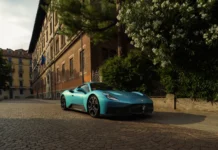
- Honda aims to build a new hydrogen vehicle based on the CR-V platform in 2024.
- It won’t necessarily carry a “CR-V Fuel Cell” name, but the automaker has not disclosed an official name just yet.
- The automaker will build this new hydrogen vehicle at its “Performance Manufacturing Center” in Marysville, Ohio.
- This fuel cell vehicle will bring a couple extra tricks to the mix, compared to its past hydrogen vehicles and those currently available on the market.
The hydrogen-powered CR-V won’t just have a fuel cell onboard.
While the Clarity Fuel Cell has been out of production for over a year now, Honda isn’t throwing in the towel on hydrogen technology. It’s actually been putting in further development into next-generation systems. The company released more information on those plans Wednesday, including what’s happening with the upcoming CR-V-based hydrogen vehicle it originally teased last year.
As it stands, the FCEV built on Honda’s new CR-V crossover is just one prong of its hydrogen-powered plans. It aims to incorporate its fuel cell systems into commercial trucks, construction machinery and stationary power plants for CO2-free electricity generation. Part of the process is its next-generation fuel cell system, which Honda is co-developing with General Motors. The two companies announced this partnership last week, and one of the finished product’s first appearances will be in the CR-V-based hydrogen model.
Now, when it does arrive in 2024, there will be a few changes from what we initially expected hearing last year’s announcement. It may not actually have the name “CR-V FCEV”, nor will it just be a fuel cell vehicle. That technology will still be at the core of the model, make no mistake, but Honda shared that it will also have a lithium-ion battery pack onboard that you can plug in, charge and drive on.
To some extent, that hybrid capability addresses hydrogen’s elephant in the room: infrastructure.
One of the biggest hurdles ahead of hydrogen vehicles building out and maintaining a fueling infrastructure for current and upcoming FCEVs. The decision to provide plug-in capability for those able to charge their vehicles overnight centers around problems from the old Clarity, wherein drivers experienced issues with the filling stations in California. Honda says it’s also working various angles to improve and expand infrastructure as well, but at least having some battery-electric driving capability alleviates that thorny problem in the short-term.
For the moment, it’s unclear how many CR-V-based hydrogen cars Honda plans to build, especially since the concept only works (insert air quotes) in California. Volumes will likely remain low, especially since the company’s building them at the PMC facility. As the transportation sector and humanity at-large pivots away from fossil fuels, though…hydrogen could come more and more into play.
Speaking of the issues mentioned above, check out Tommy’s experience fueling a Toyota Mirai FCEV:
























